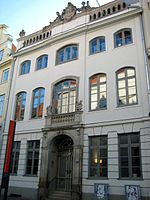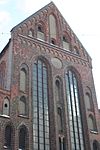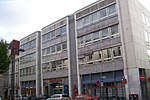Willy Brandt House, Lübeck
Buildings and structures in LübeckHouses in GermanyWilly Brandt

The Willy-Brandt-Haus in Lübeck is a museum and a memorial to the late politician Federal Chancellor and Nobel Peace Prize Laureate, Willy Brandt, of the Social Democratic Party of Germany (SPD). The Berlin based branch of the federal Chancellor Willy Brandt Foundation also houses the Office of Monumental Protection of the Hanseatic city of Lübeck, in Schleswig-Holstein. It is the third establishment in the city to honor a Nobel Prize laureate from Lübeck. The director of the Willy-Brandt-Haus is the historian, Jürgen Lillteicher. Willy Brandt was not born in this building, but in different house in the Lübeck district of St. Lorenz.
Excerpt from the Wikipedia article Willy Brandt House, Lübeck (License: CC BY-SA 3.0, Authors, Images).Willy Brandt House, Lübeck
Königstraße, Lübeck Innenstadt (Innenstadt)
Geographical coordinates (GPS) Address Phone number Website External links Nearby Places Show on map
Geographical coordinates (GPS)
| Latitude | Longitude |
|---|---|
| N 53.86973 ° | E 10.6895 ° |
Address
Willy-Brandt-Haus
Königstraße 21
23552 Lübeck, Innenstadt (Innenstadt)
Schleswig-Holstein, Germany
Open on Google Maps









